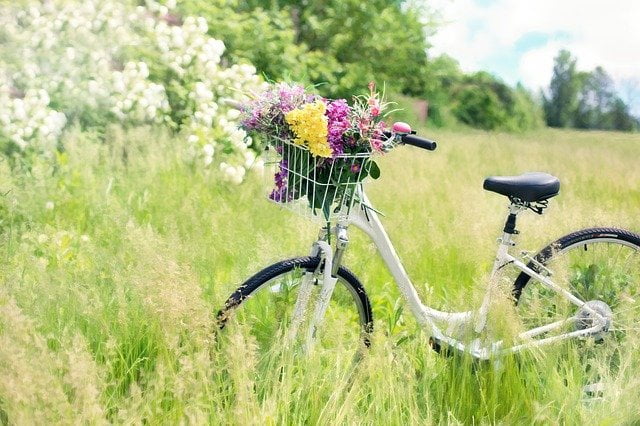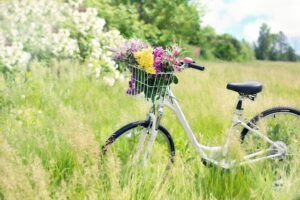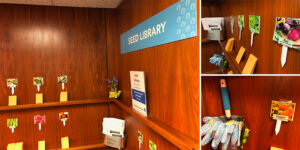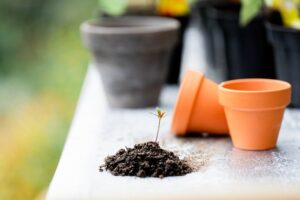
“Spring is nature’s way of saying, ‘Let’s party!’ “- Robin Williams 
It’s that time! Well, sorta. For the average gardener, early February is a bit soon to start rummaging around the frozen soil. While there are plenty of things that you absolutely CAN plant directly outside, (like leafy greens and bulby things: think lettuce, spinach, radishes, and onions) most Kansas soils are just a bit too cold to support those baby seedlings on their journeys to delicious veggies or beautiful booms.
Kansas lies in plant hardiness zone 7-5 with 7 being near the southern border and 5 at the northern. Knowing where your hardiness zone is is important in determining your planting schedule. Most seed packets will have their listed zone hardiness and approximately what time of year they should be planted within each zone. It’s best to pay attention to these suggestions because planting too early or too late could be detrimental to your plants either stunting their growth, killing them with frost or shocking the young plants into flowering too early resulting in less than bountiful harvests.
However, it’s not a bad time to start seeds indoors if you’re absolutely itching to get started. Cabbage, broccoli, brussel sprouts, cauliflower, collards, eggplant, peppers, sweet potatoes and tomatoes all benefit from an early start indoors due to the time it takes for them to start producing. Many of these can be sown directly into the soil once it warms up, but you can squeak more harvest out of them if you’re willing to start seeds inside and acclimate them once they’re big enough and the threat of frost has passed.
If you find yourself in short supply of seeds, Salina Public Library is bringing back it’s seed library. We have over 30 varieties of seeds to browse including veggies for every season and flowers to brighten up any space. It’s a perfect way to snag up something you’ve been wanting to try to grow, a fun way to teach kids about plants and where food comes from, and an easy way to get outside and enjoy the sun!

“To plant a garden is to believe in tomorrow.”- Audrey Hepburn
Before the planting season goes into full swing, there are several things you can do to prepare your garden bed for the seedlings that will make it their new home. This will make planting easier and save you time in the long run getting a lot of the dirty work out of the way.
Clearing the past year’s foliage
Amending the soil
Pruning
Clear away the old to make room for the new! Clearing past foliage is the first way to make sure the garden bed is ready for the next planting season. It’s also a fantastic time to add to an existing compost bin or start a new one. You will want to make sure you’re not adding any diseased material to the pile as this could spread it to your entire garden in a short time, but otherwise anything leftover from last year’s harvest is perfect for compost. Composting ensures that all that hard work your plants did last year doesn’t get wasted. They spent months pulling many important minerals and nutrients up from deep in the soil and while the tasty veggies are usually what we aim for, all those gathered nutrients would be otherwise wasted if they were simply thrown into the trash. For tips on starting your own compost check out “Easy Composting,” by Jeff Ball.
The next step after clearing away last year’s debris, is to amend the soil which can be implemented into your clearing process. If you’re not the type to want to watch over a compost pile, another easy method is just to flip the top soil over on top of the old growth and just mix it in with a trowel. This can be difficult with thicker stemmed dead plants like tomatoes or sunflower stalks, but since those roots run deeper they are excellent sources of minerals for the next year’s harvest. Other ways to amend the soil include adding a 1 to 2 inch layer of mulch or straw to the top of the soil, mixing in clay, gypsum or manure or adding things like lime or sulfur if your soil has any deficiencies. It’s always best to test your soil before adding amenities that adjust the pH of your soil because certain plants require more acid soil and some can’t tolerate it at all.
Time-Saving Tip! Gardening in raised beds or planters is an easy way to micromanage the pH requirements of specific plants. In this guide to raised bed gardening, Simon Akeroyd goes into much more detail about amending soil.
When in doubt, a nice layer of mulch goes a long way to retaining moisture and adding slow release nutrients throughout the growing season meaning less work for you! When it’s all said and done, just make sure the topsoil is nice and broken up and evenly flat before adding mulch otherwise water will pool in low places drowning some seedlings and leaving the others high and dry.

“There are no gardening mistakes, only experiments.”- Janet Kilburn Phillips
Pruning. Pruning can seem daunting for new gardeners. It’s daunting for me! Sometimes it feels wrong cutting off parts of your plants that they spent so much time and energy working on, but it is suggested and even beneficial if done right. As a very general rule, pruning stimulates new growth so pruning in the heat of summer when trees and shrubs are already stressed isn’t recommended. A similar difficulty arises from pruning in the fall when plants should be shutting down and snuggling in for their winter nap so pruning in winter and early spring is your best bet.
Here are some general pruning guides:
- Prune trees prior to bud break
- Completely remove dead and damaged limbs
- Cut back to or just above a growing point
- Thin out dense growth to allow for more air circulation
It’s important to note that there are many species of bushes and trees that need to be left alone in this time of dormancy, but others that can only be pruned during winter time. Always consult information guides on your specific plants for the best time of year to prune. If you need more detailed information, we have many books here at SPL that will walk you through the basics and the not so basics of snipping including: “Pruning Simplified” by Steve Bradely, “Pruning and Training” by Christopher Brickell and “Pruning” by Richard Bird.
So, if your green thumb is starting to itch or you’d like to cultivate a new one, come pick up some seeds from the seed library located by the puzzle swap on the main level. We have growing guides for all of the seeds provided that can help you get your garden started! Anyone can grab up to 4 packets per visit and enjoy watching things grow all year round. We’d love to see pictures of our seeds in action in their news homes! You can send pictures directly to me at circ.rebecca@salinapublic.org. Happy planting!

About The Author: Rebecca
Rebecca is a circulation clerk here at Salina Public Library. She has lived in Salina since shortly after she received her B.A from Bethany College in 2010. She graduated with a double major in English and a contract major in Philosophy of the 19th Century. She enjoys reading about trees, talking about plants, and nature walking on the trails around Salina. When she's not here you can find her thrifting, composting and tracking down a good coffee. She welcomes any garden pictures and can be reached at circ.rebecca@salinapublic.org.
More posts by Rebecca